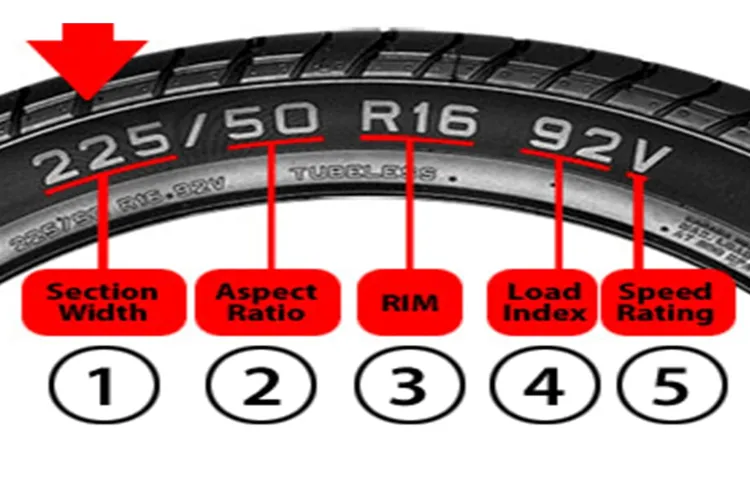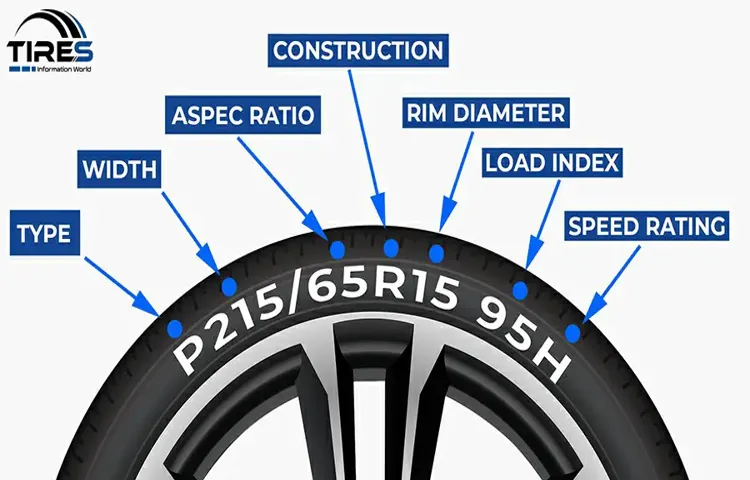Have you ever looked at the side of a tire and wondered what all those markings mean? Tire markings can be confusing, especially when you’re not familiar with the industry jargon. One of the most common markings on a tire is the number “29” What does it mean? Well, let’s take a closer look! To put it simply, “295” refers to the width of the tire in millimeters.
Specifically, it is the section width, or the distance between the outer edges of the tire’s sidewalls when mounted on a rim and inflated to its recommended air pressure. This measurement is important because it determines the tire’s contact patch, which is the portion of the tire that meets the road. A wider contact patch can provide better grip and handling, but it may also increase rolling resistance and fuel consumption.
But that’s not all! Tire markings can also tell you important information about the tire’s load carrying capacity, speed rating, and manufacturing date. Understanding these markings can help you choose the right tire for your vehicle and driving needs. Plus, it’s always a good idea to keep an eye on your tire’s condition and replace them when necessary to ensure your safety on the road.
So next time you’re browsing the tire aisle or checking the sidewalls of your current tires, you’ll know exactly what that “295” means. And who knows, maybe you’ll impress your friends with your newfound tire knowledge!
Understanding Tire Markings
If you see the number “295” on a tire, that’s actually its width in millimeters! Tire markings can seem like a foreign language, but they’re actually full of useful information. The number before the slash is the width, while the number after the slash is the aspect ratio, or the tire’s height as a percentage of its width. The letter “R” means it’s a radial tire, which is the most common type of tire on the road today.
Following that is the diameter of the wheel, measured in inches. Understanding these markings can help you choose the right tires for your vehicle and ensure your safety on the road. So next time you’re shopping for new tires, make sure you’re familiar with these markings and what they mean!
Tire Size and Load Index
When it comes to vehicle maintenance, understanding tire markings can make all the difference. Two of the most important markings are tire size and load index. The tire size indicates the width, aspect ratio, and diameter of the tire, while the load index indicates the maximum weight that the tire can support.
As a driver, it is important to ensure that the tires on your vehicle can handle the weight of your car and any additional cargo you may be carrying. Ignoring the load index can lead to dangerous situations on the road, including blowouts and loss of control. It’s important to remember that bigger isn’t always better – just because a tire is larger in size, doesn’t necessarily mean it has a higher load index.
When purchasing new tires, it’s essential to consult the vehicle’s owner’s manual or a trusted professional to ensure you are selecting the correct size and load index for your vehicle. By understanding and respecting these tire markings, you can help ensure a safe and smooth ride on the road.

Tire Type and Speed Rating
When it comes to understanding tire markings, it’s important to pay attention to the tire type and speed rating. The tire type refers to the design and intended use of the tire, such as all-season, winter, or performance. On the other hand, the speed rating indicates the maximum speed that the tire can handle safely.
Both of these markings can be found on the sidewall of the tire, usually in the form of letters or numbers. It’s essential to choose the right tire type and speed rating for your vehicle to ensure optimal performance, safety, and longevity. Selecting the wrong type or rating could result in increased fuel consumption, reduced handling, and a higher risk of accidents.
That’s why it’s always worth consulting with a professional or checking your vehicle manual before making any tire purchases. So, be sure to pay attention to those tire markings and make informed decisions when it comes to your vehicle’s tires.
Cracking the Code: Decoding ‘295’
If you’ve ever looked closely at a tire, you may have noticed a series of numbers and letters imprinted on the sidewall. One of these numbers is “29” So, what does 295 mean on a tire? It actually refers to the tire’s width in millimeters.
This measurement is taken from one sidewall to the other, and is an important factor in determining the tire’s overall size and fit. Knowing the width of a tire is especially important for ensuring proper alignment and balance on your vehicle. It also helps to ensure that the tire performs optimally in terms of grip, handling, and stability.
So, the next time you’re shopping for tires, make sure to pay attention to the width measurement, indicated by the three-digit number starting with “2” or “3,” such as “29”
Interpreting the Number ‘295’
If you’ve come across the number “295” and are wondering what it means, you’re not alone. This number can have different interpretations depending on the context. For example, in math, it could represent a value in an equation.
In a date format, it could represent the year 295 AD. But if you’ve noticed this number appearing in different places regularly, it might be a sign that it has some significance or meaning for you personally. One interpretation of “295” could be to trust your intuition and inner wisdom.
It could be a message from the universe reminding you to listen to your gut instincts and make decisions based on what feels right for you. Trusting yourself and your intuition can lead to positive outcomes and a sense of alignment with your true self. So next time you see “295,” pause and listen to what your inner guide is telling you.
What Does ‘295’ Indicate about Tire Size?
If you’ve ever looked at a tire and seen the numbers “295,” you may have wondered what it means. Luckily, we’re here to crack the code for you! “295” refers to the tire width in millimeters. This means that the tire is roughly 1
6 inches wide. It’s important to note that tire width can affect a variety of factors, including handling, grip, and fuel economy. Generally, wider tires offer better grip and handling, but can negatively impact fuel economy.
So, when selecting new tires for your vehicle, it’s important to take the width into consideration and weigh the potential trade-offs. By understanding the significance of “295,” you’ll be better equipped to make an informed decision when it comes to your vehicle’s tires.
Other Important Information to Consider
If you’re unfamiliar with the term ‘295,’ it can be quite confusing. ‘295’ refers to a section of Indian law that criminalizes hurting or defiling religious sentiments. It’s a highly controversial section, as it has been used to silence critics of the government and repress free speech.
Recently, it has gained even more attention due to the case of Munawar Faruqui, a comedian who was arrested and jailed under this section based on accusations of making jokes that offended Hindu sentiments. While some argue that it’s necessary to prevent hate speech against different religions, others argue that it’s being used to suppress dissenting voices. As the debate over the interpretation and implementation of ‘295’ continues, it’s important to consider the impact this section has on freedom of expression and how it can be used to restrict it.
Conclusion
In conclusion, 295 on a tire is not just a simple number. It’s like the tire’s own unique date of birth, revealing its width in millimeters. So next time you’re admiring a handsome set of wheels, impress your friends by letting them know that 295 is not just a number, it’s the tire’s way of saying “back off, I’m a bold and beefy powerhouse of rubber!”
Why You Should Pay Attention to Tire Markings
Tire markings can be confusing, and it can be tough to know how to decipher what all the numbers and letters mean. However, it’s essential to pay attention to these markings because they can give you valuable information about your tires, including their size, speed rating, and load index. One of the most critical markings on your tire is the “295,” which refers to the width of the tire in millimeters.
This number is essential because it can tell you whether the tire will fit your vehicle properly. If you have a tire that is too narrow or too wide, it can affect the safety and handling of your car. By understanding the meaning of these markings, you can make informed decisions about what tires to buy and ensure that your vehicle is as safe as possible on the road.
So the next time you’re shopping for tires, take a closer look at the markings and make sure you’re choosing the right ones for your vehicle.
Getting the Right Tires for Your Vehicle
When it comes to buying tires for your vehicle, the process can seem overwhelming at first. With so many different options and specifications to consider, it can be difficult to know where to begin. One key factor to understand is tire size, which is typically represented by a code like ‘295’ that can be found on the sidewall of the tire.
This code can initially seem like a cryptic jumble of numbers and letters, but actually contains important information about the tire’s width, aspect ratio, and diameter. For example, in the case of ‘295’, the first number refers to the tire’s width in millimeters, while the second number represents the tire’s aspect ratio or height as a percentage of its width. The final number indicates the tire’s diameter, or the size of the wheel it will fit.
Understanding how to decode this code can help you choose the right tires for your vehicle and ensure optimal performance and safety. So next time you’re in the market for new tires, don’t be intimidated by those seemingly random numbers – crack the code and make an informed decision about the best tires for your needs.
FAQs
What do the numbers on a tire mean?
The numbers on a tire indicate its size, type, and performance ratings.
How do I know if my tire size is compatible with my vehicle?
You can check your vehicle’s owner manual or the tire placard for the recommended tire size.
What does 295 mean on a tire?
295 is the width of the tire measured in millimeters from sidewall to sidewall.
What is the importance of tire pressure?
Maintaining proper tire pressure helps improve fuel efficiency, tire longevity, and overall safety while driving.
Can I replace one tire at a time or should I replace all four tires at once?
It is recommended to replace all four tires at once for even wear and optimal performance. However, if only one tire needs replacement, it is important to ensure it matches the others in terms of size and type.
What is the difference between summer tires and winter tires?
Summer tires are designed for optimal performance in dry and warm conditions, while winter tires are designed for better traction in cold and wet conditions.
How often should I rotate my tires?
It is recommended to rotate your tires every 5,000 to 7,000 miles to ensure even wear and prolonged tire life.



